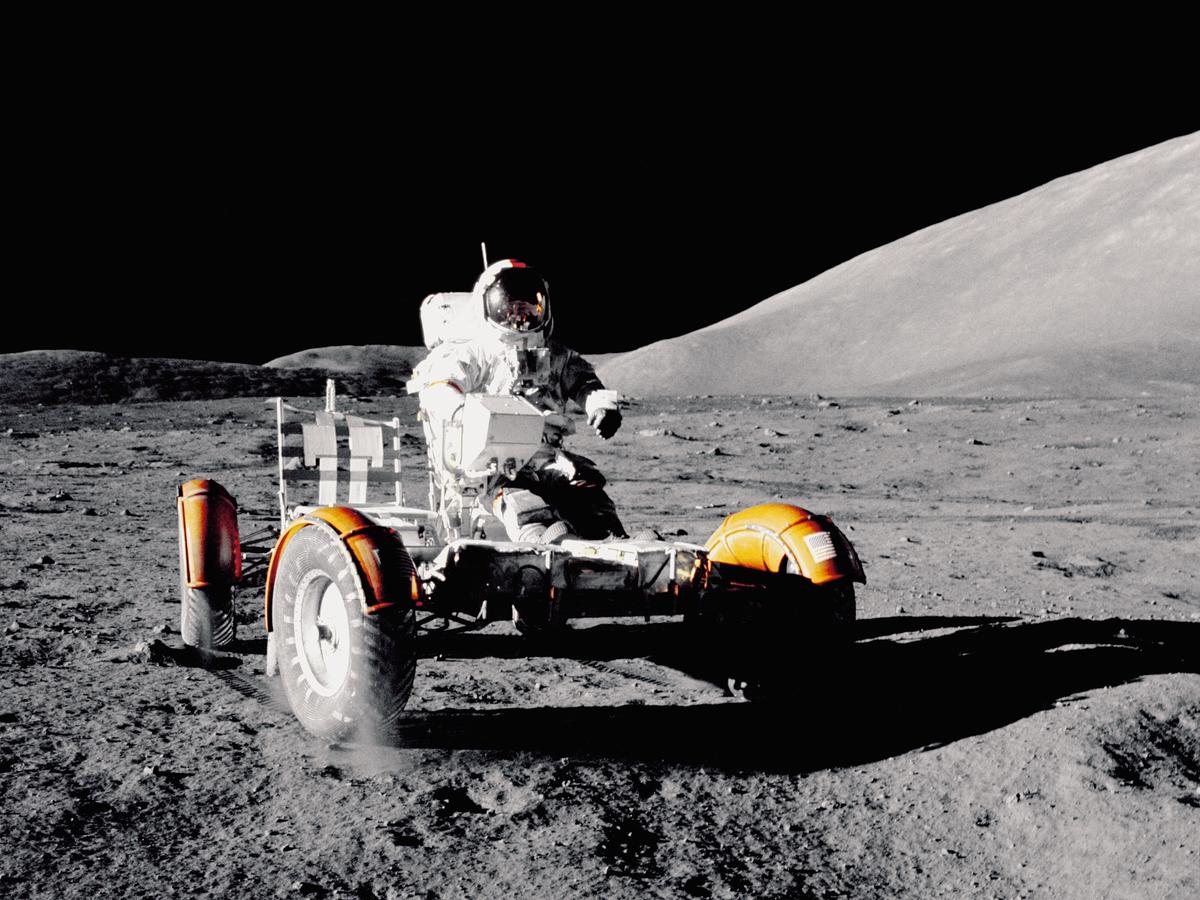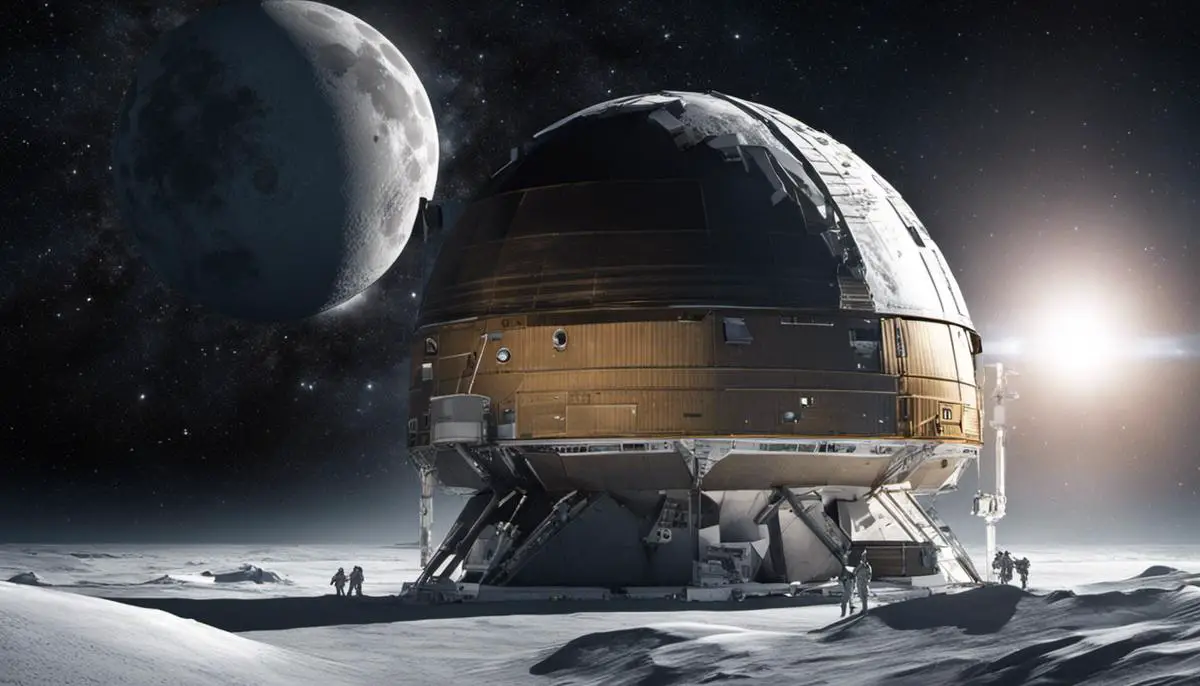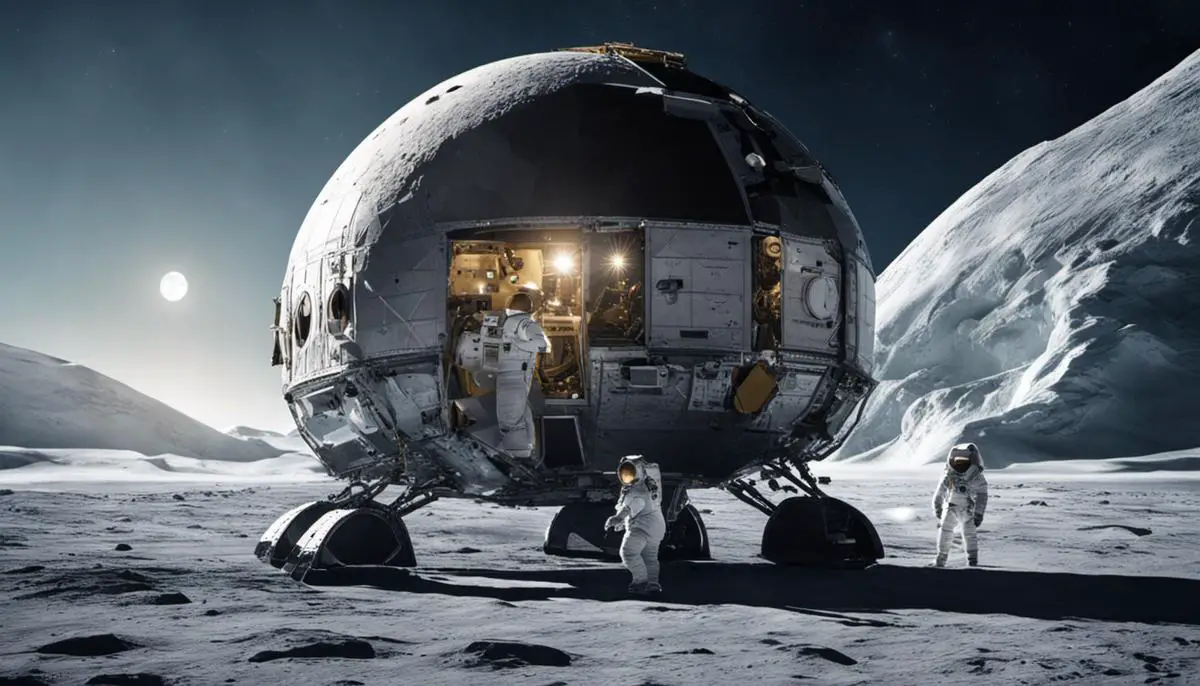Our understanding of the universe continues to evolve, fueled in part by ambitious space missions conducted by organizations such as NASA. One such mission is the exploration of the Moon’s South Pole, a largely untouched region with tremendous scientific interest. This expedition forms part of the Artemis program, an exciting venture with the audacious goal of returning astronauts to the lunar surface by 2024. Simple as it sounds, this mission is a complex arrangement of advanced technological devices orchestrated to achieve a singular purpose. The journey, however, won’t be without its challenges; the lunar South Pole presents some unique environmental complications. Despite these issues, the overall impact of this endeavor is expected to revolutionize our understanding of the Moon, open the pathway to future explorations and potentially set the stage for long-term cosmic habitation.
Background and Purpose of the Lunar South Pole Mission
Background: The Fascination with the Moon’s South Pole
Over the decades since the first human Moon landing in 1969, exploration of Earth’s celestial neighbor has mostly been concentrated around its equatorial region. However, the trend in lunar exploration has gradually shifted toward the Moon’s poles, particularly the south pole, due to the potential for water ice deposits. Unlike the equatorial areas, the south pole of the moon possesses permanently shadowed regions that are believed to have collected water in different forms, discovered by prior missions such as NASA’s Lunar CRater Observation and Sensing Satellite (LCROSS) and Lunar Reconnaissance Orbiter (LRO).
Purpose: NASA’s Lunar South Pole Mission
NASA is keen on studying the south pole region for various reasons. Maintaining a sustainable presence on the Moon is a major goal of NASA’s Artemis program, with potential habitats likely being set up at the south pole. The mission aims to land astronauts on the lunar south pole by 2024, with the belief that such exploration could open up opportunities for further space discovery, lunar habitation, and eventually, Mars exploration. Uncovered lunar resources like water can be used for life support, generate rocket propellant and even support the development of an economy in space.
Relevance to Understanding the Moon and Future Space Missions
The lunar south pole is uniquely positioned to offer more hours of sunlight for power and has a stable thermal environment, making it an ideal location for human habitability compared to the temperamental extreme temperatures of the lunar surface. Water ice at the south pole also suggests potential resources that could fundamentally change our approach to long-duration space exploration, making lunar habitation more feasible. Moreover, the preservation of the lunar poles makes them a rich geochemical archive, which could offer profound insights into the history of the Moon, Earth, and the solar system.
Exploring the Lunar South Pole
Exploring the lunar south pole will not merely mean the revisiting of an old frontier but offers a testing ground for deeper space exploration missions such as manned missions to Mars or beyond. Understanding the innovative technologies required to take humans to the lunar south pole and to exploit its resources could serve as a blueprint for future space missions. It paves the way for NASA’s Mars exploration strategies, which aim to reduce dependability on Earth’s resources, making the concept of a self-sustaining outpost in a celestial body more realistic.
Understanding NASA’s Greater Aim
In undertaking its lunar south pole mission, NASA is primarily driven by the objective of cultivating international and commercial collaborations for lunar exploration. This is meant to form a large-scale and evolving frontier for human expedition. But the mission’s purpose goes beyond exploration and habitation. It is also about laying the foundation for a civilization that can thrive in space.

The Artemis Program
The Artemis Program: A Focused Approach to Lunar South Pole Exploration
The Artemis program is a bold initiative launched by NASA with the goal of getting the first woman and the next man to the moon by 2024. The plan is to have the spacecraft land in the Moon’s south pole region which was chosen due to its ample sunlight that can be harnessed for power, and significant volumes of water ice, potentially convertible into drinking water, breathable air, and rocket propellant.
At its core, the Artemis program is a multifaceted endeavor. Through it, NASA is seeking to unravel more about the Moon’s history and evolution, as well as uncovering opportunities to trial novel technologies. These range from renewable solar power generation to autonomous robotics and sophisticated navigation systems, making the mission’s reach wide and in-depth.
Key Milestones in the Artemis Program
The Artemis program is structured in multiple phases, with each phase marked by significant milestones. Artemis I, an uncrewed mission, is slated to test the Orion spacecraft and the massive Space Launch System (SLS) rocket. This mission signals the renewal of lunar exploration while setting the stage for future manned missions.
Artemis II is anticipated to fly with a crew on board, marking the first manned mission launched by the SLS. This mission will take a far circumlunar trajectory, traveling farther from Earth than any crewed spacecraft has ever gone.
Artemis III is the mission that will finally place astronauts on lunar soil. Preceding Artemis III, several commercial delivery missions will deliver supplies and scientific instruments to the lunar surface, preparing the ground for the crew landing.
The Significance of the Artemis Program
Beyond its immediate goals of reaching the Moon, the Artemis program holds vast significance for the future of space exploration. By landing on the lunar south pole, we can learn more about the Moon’s water ice—knowledge that can potentially revolutionize life support systems for long-duration space travel. Additionally, this knowledge will be instrumental in future Martian expeditions and beyond.
The Artemis Program will also enlist commercial and international partners, enhancing scientific research and encouraging commercial participation in ambitious exploratory activities.
An Overview of Technologies Leveraged in the Lunar South Pole Mission
At the heart of this ambitious endeavor is NASA’s Artemis program, which is powered by a slew of cutting-edge technologies. The Orion Multi-Purpose Crew Vehicle, a masterpiece crafted by Lockheed Martin, is set to transport astronauts from Earth to the Moon. Playing a vital role in this mission is NASA’s super heavy-lift expendable launch vehicle, the SLS. It is touted as the most powerful rocket ever constructed, designed specifically to propel the Orion capsule, carrying the astronauts, into space.
To ensure the astronauts’ safe landing on the moon’s surface, NASA’s contemporary Human Landing System (HLS) has been deployed. Equally pivotal to the mission is the Gateway, a compact spaceship that will linger in lunar orbit. This spaceship will act as a transitory habitat and workspace for astronauts, ensuring a sustainable lunar exploration. It also presents an opportunity to test and validate advanced space travel technologies in a real-world scenario.

Photo by joehan330 on Unsplash
The Technological Aspects
Unfolding NASA’s Lunar South Pole Mission: A Voyage Fueled by Technological Marvels
NASA’s mission to the lunar south pole is a testament to the power of modern technology. The crux of the mission is to explore the lunar south pole, seeking traces of water ice and other precious resources. This task not only expands human knowledge about our natural satellite but also paves the way for potential future human settlement. The amalgamation of state-of-the-art equipment and advanced technology is what propels this mission, bringing together unparalleled scientific exploration and human perseverance.
Spacecraft and Rovers: The Core of the Mission
Critical to the mission are the spacecraft and rovers. The Gateway is an integral spacecraft in NASA’s plans to return to the moon, serving as a rendezvous point for astronauts traveling to the lunar surface. It also acts as a staging point for deep space missions. The Lunar Gateway is functionally designed with living quarters, laboratories for science and research, docking ports, and storage for rovers and other robots.
Rovers and robots play an essential role in this mission. The VIPER (Volatiles Investigating Polar Exploration Rover) is one such rover. It is an autonomous, solar-powered rover designed to prospect for water ice located at the moon’s south pole. Its instruments allow it to drill into the lunar surface to a depth of one meter and evaluate the water content below the surface consequently. These tools also allow it to capture data on the moon’s geology and radiative environment.
Innovation and Advancement in Technological Capabilities
The lunar south pole mission also employs other groundbreaking technologies, one of which is the Lunar Flashlight, a small, innovative spacecraft that will look for ice deposits and explore the lunar surface for resources. It uses a near-infrared laser light to probe the lunar south pole’s permanently shadowed regions, posing opportunities for future use by human explorers or prospective robots.
The LRO (Lunar Reconnaissance Orbiter) is another significant technological aspect of NASA’s lunar south pole mission. It’s a robotic spacecraft that maps the lunar surface and aims to identify safe landing sites, locate potential resources, and describe the moon’s radiation environment.
An additional component of the mission’s technological lineup is the Human Landing System (HLS), a spaceship that will transport crew members from the Lunar Gateway to the moon’s surface. It’s innovative in design to navigate the unique challenges posed by the moon’s terrain and gravity.
Advanced Technology’s Crucial Role in the Mission
NASA’s lunar south pole mission heavily relies on utilizing cutting-edge technology, encompassing spacecraft, rovers, and state-of-the-art instruments. The primary objective of these tools is to foster a comprehensive understanding of the Moon’s south pole through the discovery of resources, such as water ice. The detection of such resources can potentially become the cornerstone of sustainable lunar exploration and build groundwork for future manned missions to Mars.
In essence, the south pole voyage is instrumental in bridging the gap between technology and science. All elements contribute to the success and attainment of the mission objectives.

Challenges Expected and Mitigation Strategies
Enduring Extreme Temperatures at the Lunar South Pole
The environmental extremities of the lunar South Pole represent a significant challenge to NASA’s mission. With temperatures plummeting to an extreme minus 238 degrees Fahrenheit (or minus 150 degrees Celsius), the south pole is counted amongst the coldest regions in our solar system. This hostile environment imposes serious constraints on human and robotic exploration, specifically regarding the function and endurance of technological instruments. The lack of an atmosphere to retain heat intensifies these constraints, leading to quick transitions from intense heat to bitter cold.
To tackle these drastic temperature fluctuations, NASA aims to incorporate an arsenal of cutting-edge technologies and resilient materials capable of enduring such harsh conditions. NASA envisions employing durable solar panels capable of efficiently operating in significantly low temperatures, in addition to materials designed to protect spacecrafts and equipment from high-intensity solar radiation. Furthermore, NASA is studying insulation strategies to protect both humans and equipment from temperature-induced damages.
Rocky Terrain and Challenges in Navigation
The lunar south pole is filled with craters and rugged terrain, adding another layer of complexity to the mission. The surface of the south pole is uneven and reliable navigation on this terrain is a significant challenge. There are also numerous shadows due to the tilt of the lunar terrain, leading to areas that have not seen sunlight for billions of years.
NASA will employ advanced navigation systems and pre-planned paths to navigate this terrain, with ground penetrating radar solutions on rovers to study the terrain ahead for safer routing. Robotic systems would also be maximized to survey the area before any human mission.
Long Lunar Nights and Energy Management
A lunar night lasts about 14 Earth days. This long duration without sunlight poses challenges to maintaining power for NASA’s equipment, including scientific instruments and life support systems.
To tackle this, NASA aims to develop new energy storage technologies that can keep the spacecraft functional through the lunar night. These technologies include improved batteries, fuel cells and potentially miniature nuclear reactors. Emplacement of solar panels in near permanent illuminated areas at the lunar south pole is another strategy NASA might use to ensure continuous power supply.
Safety Measures and Contingency Plans
NASA has always placed the utmost priority on safety for all missions. For the lunar south pole mission, special space suits designed to deal with the harsh lunar environment are being developed. These suits will provide astronauts with life support and protection from the lunar environment.
Furthermore, NASA is also developing autonomous systems that can monitor the health of astronauts and the status of the equipment. In the event of unforeseen circumstances, these systems can alert mission control on Earth and initiate contingency plans to ensure the safety of astronauts.
Moving Forward
Despite the expected challenges in executing a lunar south pole mission, NASA is meticulously preparing to overcome these obstacles. The agency is utilizing innovative technology and continuously expanding the limits of human knowledge and engineering to make certain that their missions are carried out safely and successfully.

The Expected Impact and Future Implications
Advancements in Space Exploration
The lunar South Pole mission led by NASA has the potential to be a substantial turning point in the long history of space exploration. NASA is concentrating on the largely uncharted Moon’s South Pole to collect valuable data about the lunar environment, specifically the suspected presence of ice water. Uncovering the secrets behind this unique lunar attribute could drastically transform our understanding of the Moon as well as our ability to utilize its resources. This mission is an intricate part of the much bigger Artemis program, which is ambitiously striving for the long-term human habitation of the Moon by the end of this decade.
Furthering Lunar Understanding
The comprehensive study of the lunar South Pole will contribute deeply to our understanding of the Moon. With the detailed inspection of the permanently shadowed craters, scientists can gain further insight into lunar geology, climatology, and possibly the history of moonquakes. This may also lead to more knowledge about how frozen volatiles such as water ice were deposited in these craters, providing new clues about the Moon’s history and evolution. Perhaps most importantly, this research could potentially discover other useful resources for future lunar visitors.
Contribution to future space explorations
Achieving the objectives of the lunar south pole mission will be a significant step towards the long-term goal of establishing humans on the Moon and other celestial bodies. As NASA plans to create a sustainable lunar outpost by 2028, findings from this mission could provide invaluable data for achieving this objective – from insights regarding necessary habitat conditions to potential resource extraction methods, such as utilizing lunar water for life support systems or fuel for spacecrafts. Additionally, data collected could offer useful information for developing techniques for in-situ resource utilization (ISRU).
Understanding the lunar South Pole environment and resources available also establishes a precedent for future missions beyond the Moon. The logistics of staying on the Moon for longer periods can have implications for how these endeavors might occur on other celestial bodies like Mars. If humans can successfully utilize resources and live sustainable on the lunar south pole, then long-term missions to Mars or elsewhere become more feasible as a subsequent step. These missions would take advantage of the lessons learned from the extreme lunar climates as a steppingstone for future interplanetary journeys.
Potential for Long-term Colonization
The lunar South Pole mission sets the groundwork for potential long-term colonization of the Moon. The discovery of significant amounts of water ice in the Moon’s polar regions during this mission could drastically alter plans for long-term lunar habitation. This water could be used to produce oxygen for astronauts to breathe and hydrogen as rocket fuel, eliminating the need to transport these resources from Earth. This could substantially reduce the cost and complexity of future lunar missions, encouraging more frequent and longer stays on the Moon. Moreover, it nurtures the idea of the Moon as a launching pad for deep space exploration or even as an extraterrestrial human settlement.
Summary: Lunar South Pole Mission – A Stepping Stone into the Future
The lunar South Pole mission is pivotal in shaping the future of space exploration. It will revolutionize our understanding of the Moon and provide valuable comprehensions for future lunar missions, including potential long-term colonization and resource utilization. Most importantly, it serves as a cornerstone for future missions to Mars and beyond, providing an essential platform to test technologies, systems, and operational techniques that will pave the way for the next giant leap into the cosmos.

The attempt to conquer the lunar south pole is by no means a mere adventure; it is a deliberate step towards understanding our universe better. It is as much about dealing with the moon’s grueling environment as it is about paving the way for future missions to Mars and other planets. NASA’s ambitious mission, incorporating modern technology and learning from past trials, may well redefine the benchmarks of space exploration. The stakes are certainly high, but the potential rewards – advancing our knowledge of the Moon, priming future space missions, and eventually enabling long-term colonization – make it an invaluable endeavor. Indeed, our quest for cosmic truth continues, with the lunar south pole serving not only as a destination but also as a launchpad towards the unexplored frontiers of space.
![]()
